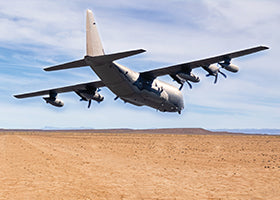
By Jim Reardon, One Stop Systems
The OpenVPX standards occupy a special place in deployed military compute platforms. Designed as a successor to VME64, the OpenVPX (ANSI 65) and related standards such as SOSA have offered the opportunity to package COTS systems that meet the challenging environmental and electrical requirements of military vehicles across all services. AI Transportable systems incorporate GPUs and switched fabrics that were not envisioned by the existing standard and threaten to force significant new investment in product development before deployment of next generation systems such as C4ISR.
AI Transportable systems, such as the One Stop Systems' Rigel, achieve extraordinary compute performance by use of multiple GPUs and new generation switched fabrics, such as PCIe Gen4 and NVIDIA® NVLink. Today, these elements do not map well into the legacy standard. Among the significant challenges are power supply, conduction cooling, and the limitations of the OpenVPX backplane definition that limit PCIe lane capacity. To preserve the significant industry and government investment in OpenVPX products, a hybrid solution is needed to gain the performance benefits of GPUs, such as NVIDIA® A100 Tensor Core GPUs in next-generation deployments.
With the introduction of Rigel, we can now offer product extensions to support existing OpenVPX and SOSA-compliant sensor I/O, while offering direct access to the performance of Rigel GPUs where it is useful to support new and more demanding applications. Relying on OSS experience with PCIe Gen4 (and now Gen5) expansion, such a combination is now architecturally feasible, offers reduced sensor latency (with the potential to completely bypass host memory buffers), while preserving two decades of industry and government investment in existing SOSA interface solutions.
At the heart of a Rigel system is a PCIe Gen 4 switched fabric that provides the capacity to support the NVIDIA HGX™ module, which itself consists of four NVIDIA® A100 GPUs. Each of the GPUs features an external 16-lane PCIe connection, as well as private NVIDIA NVLink connection to the other GPUs. To manage access to the GPUs, Rigel manages this complexity by implementing a versatile PCIe switched fabric and related management software that allows dynamic or fixed lane routing between GPUs, hosts, memory, and I/O according to application demands. Of course, the PCIe requirements of SOSA-compliant accessories in VPX format is accomplished by extending the PCIe Gen 4 Host Bus Adapter expansion technology developed by OSS.

Through OpenVPX extensions to Rigel, new levels of low-latency sensor acquisition are possible. Direct access to memory in the GPUs without transit through host memory is possible, unlocking new levels of sensor bandwidth as latency is reduced. By way of this architecture, the role of the host processor gives way to the GPUs, which can offer greater computing power, flexible data formats, and of course, parallelism.
In AI Transportables, GPUs and switched fabrics will play a key role in lifting the legacy application performance limits. Combining Rigel and OSS host bus adapter and extender technology, the life of legacy SOSA interfaces can be extended. Placing the managed switch fabric at the heart of these applications, even the GPU elements can be replaced with newer generations, while preserving other elements of the system for reuse.
If you would like to learn more about hybrid Rigel, please be in touch!
Click the buttons below to share this blog post!

By: Jaan Mannik – Director of Commercial Sales
The term AI, or Artificial Intelligence, is everywhere nowadays and has quietly woven itself into the fabric of our daily lives. It powers the recommendations we see on streaming platforms, the navigation apps that guide us through traffic, and even the virtual assistants that answer our questions in seconds. From optimizing energy use in smart homes to predicting market shifts in finance, AI has become the invisible engine driving convenience, efficiency, and insight across industries.
In manufacturing, AI-driven robots collaborate with humans to streamline production. In agriculture, machine learning models monitor crops, forecast yields, and conserve resources. Retailers use predictive analytics to anticipate consumer needs before customers even express them. The reach of AI is no longer confined to futuristic labs, it’s in our phones, vehicles, and cities, constantly learning and adapting to serve us better.

OSS PCIe-based products deliver critical advantages for modern military sensor systems by enabling real-time data acquisition, processing, and transmission in rugged, mission-critical environments. These benefits stem from their ability to support high-bandwidth, low-latency interconnects, modular scalability, and environmental resilience, all of which are essential for today’s advanced military platforms.

Companies today are being asked to do more with data than ever before. Bigger AI models, faster insights, and workloads that don’t stay in one place, it’s a lot to keep up with. Traditional infrastructure just isn’t built for this kind of speed and flexibility.
The answer isn’t about throwing more hardware at the problem. It’s about building smarter, more agile infrastructure that adapts as demands change. And that’s where scale-out and increasingly, a blend of scale-out and scale-up come into play.